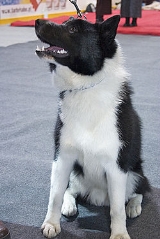
Russo-European Laika
Encyclopedia
Russo-European Laika (Russko-Evropeïskaïa Laïka) is the name of a breed
Dog breed
Dog breeds are groups of closely related and visibly similar domestic dogs, which are all of the subspecies Canis lupus familiaris, having characteristic traits that are selected and maintained by humans, bred from a known foundation stock....
of hunting
Hunting dog
A hunting dog refers to any dog who assists humans in hunting. There are several types of hunting dogs developed for various tasks. The major categories of hunting dogs include hounds, terriers, dachshunds, cur type dogs, and gun dogs...
dog
Dog
The domestic dog is a domesticated form of the gray wolf, a member of the Canidae family of the order Carnivora. The term is used for both feral and pet varieties. The dog may have been the first animal to be domesticated, and has been the most widely kept working, hunting, and companion animal in...
that originated in the forested region of northern Europe and Russia, one of several breeds developed from landrace Laika
Laika (dog breed)
Laika refers to a type of hunting dog of Northern Russia and Russian Siberia, and is a generic name for several breeds.-The Laika breeds in international terminology:Fédération Cynologique Internationale uses the word Laika in the names of...
dogs of very ancient Spitz type
Dog type
Dog types are broad categories of dogs based on function, with dogs identified primarily by specific function or style of work rather than by lineage or appearance....
. The Russo-European Laika itself dates to a breeding program begun in 1944 by E. I. Shereshevsky of the All-Union Research Institute for the Hunting Industry, in Kalinin
Kalinin
Kalinin , or Kalinina , is a Russian surname, derived from the word kalina , and may refer to:People with the surname...
(now Tver
Tver
Tver is a city and the administrative center of Tver Oblast, Russia. Population: 403,726 ; 408,903 ;...
) Province.
Breed recognition
The Russo-European Laika is recognized by the Fédération Cynologique InternationaleFédération Cynologique Internationale
Fédération Cynologique Internationale is an international federation of kennel clubs based in Thuin, Belgium. The English language translation, World Canine Organisation, is not often used.Its goals are described in Article 2 of their regulations:...
in the Spitz and Primitive types/Section 2: Nordic Hunting Dogs Group. The breed is listed as breed number 304, along with two other Russian dogs, breed number 305, the Vostotchno-Sibirskaïa Laïka (East Siberian Laïka) and breed number 306, the Zapadno-Sibirskaïa Laïka (West Siberian Laïka).
Breed standard
The Russo-European Laika is described as being of medium size, males being about 54 to 60 cm (21.3 to 23.6 in) at the withers and females about 52 to 58 cm (20.5 to 22.8 in). The breed has prick ears and a sickle tail carried over the back. Temperament should be non aggressive. Colour can be any of the normal Spitz-type colours, but red and ticking on the legs is undesirable.Temperament
This is a lively breed that enjoys time spend in the great outdoors. As a hunter who frequently trees game, the Russo-European Laika uses its voice to alert the hunter to the treed prey (typically a raccoon or squirrel). It may use its voice freely in the house as well because it is easily excited about things going on around it. The Russo-European Laika has a strong love of family. Once bonded to them, it is quite territorial and makes an excellent guard dog. It is extremely tolerant of children, although not of strangers or other unfamiliar dogs.Eager to please and with energy to spare, the Russo-European Laika benefits tremendously from training of any kind. Socialization must begin in puppyhood and continue throughout its life. Obedience classes or participation in a working association will give it a sense of purpose and the frequent exercise it requires. With those opportunities, it will learn quickly and become well balanced as a family dog.

